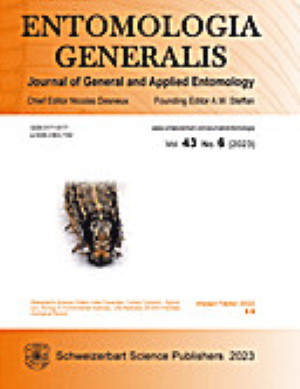预测欧洲大陆新蝽害的到来:我们能从生物控制的先期宿主特异性试验中学到什么?
IF 4.6
1区 农林科学
Q1 ENTOMOLOGY
引用次数: 0
摘要
卵寄生虫 Gryon aetherium Talamas(膜翅目:鞘翅目)是美国西南部对 Bagrada hilaris Burmeister(半翅目:五蠹科)进行生物防治的理想候选者。Bagrada hilaris 是一种全球入侵的十字花科作物害虫。本研究旨在评估寄生虫在欧洲的寄主范围。这些测试是对加利福尼亚州正在进行的研究的补充,并为 G. aetherium 在欧洲大陆南部的潜在释放提供了风险信息。在测试的 11 种非目标物种中,有 4 种五步蛇属于 G. aetherium 的生理寄主范围:Carpocoris mediterraneus、Dolycoris baccarum、Graphosoma italicum 和 Ancyrosoma leucogrammes。这四个物种的寄生率在选择条件下比非选择条件下低。令人惊讶的是,与喜乐蒂丝虫同属一个科(Strachiini)并以十字花科植物为食的三个 Eurydema spp.没有被寄生。在世界性入侵的五蠹类 Nezara viridula 和 Halyomorpha halys 以及蚜虫类 Liorhyssus hyalinus 上也没有观察到寄生现象。在非目标物种上发育的寄生虫比在喜乐蒂上发育的寄生虫大,完成发育需要更多时间。本文章由计算机程序翻译,如有差异,请以英文原文为准。
Anticipating the arrival of a new stinkbug pest in continental Europe: what can we learn from preemptive host specificity tests for biocontrol?
The egg parasitoid Gryon aetherium Talamas (Hymenoptera: Scelionidae) is a promising candidate for biocontrol of Bagrada hilaris Burmeister (Hemiptera: Pentatomidae) in the Southwestern USA. Bagrada hilaris is a worldwide invasive pest of crops in the family Brassicaceae. The present study aims to evaluate the parasitoid’s host range in a European context. These tests complement studies underway in California and provide risk information for a potential release of G. aetherium in southern continental Europe where B. hilaris is likely to spread in the future. Of the 11 non-target species tested, four pentatomids were in the physiological host range of G. aetherium: Carpocoris mediterraneus, Dolycoris baccarum, Graphosoma italicum and Ancyrosoma leucogrammes. Parasitism rates on these four species were lower in choice than in no-choice conditions. Surprisingly, the three Eurydema spp. that belong to the same tribe as B. hilaris (Strachiini) and feed on plants in the family Brassicaceae were not parasitized. No parasitism was observed on the cosmopolitan invasive pentatomids Nezara viridula and Halyomorpha halys, nor on the rhopalid Liorhyssus hyalinus. Parasitoids that developed from non-target species were larger than ones developing on B. hilaris and took more time to complete development.
求助全文
通过发布文献求助,成功后即可免费获取论文全文。
去求助
来源期刊

Entomologia Generalis
生物-昆虫学
CiteScore
7.10
自引率
18.80%
发文量
72
审稿时长
>12 weeks
期刊介绍:
Its scope covers all aspects of basic and applied research dealing with insects and more broadly with arthropods inhabiting wild, agricultural and/or urban habitats. The journal also considers research integrating various disciplines and issues within the broad field of entomology and ecology.
Entomologia Generalis publishes high quality research articles on advances in knowledge on the ecology and biology of arthropods, as well as on their importance for key ecosystems services, e.g. as biological control and pollination. The journal devotes special attention to contributions providing significant advances (i) on the fundamental knowledge and on sustainable control strategies of arthropod pests (including of stored products) and vectors of diseases, (ii) on the biology and ecology of beneficial arthropods, (iii) on the spread and impact of invasive pests, and (iv) on potential side effects of pest management methods.
Entomologia Generalis welcomes review articles on significant developments in the field of entomology. These are usually invited by the editorial board, but proposals may be sent to the Editor-in-Chief for preliminary assessment by the editorial board before formal submission to the journal. The journal also considers comments on papers published in Entomologia Generalis, as well as short notes on topics that are of broader interest.
 求助内容:
求助内容: 应助结果提醒方式:
应助结果提醒方式:


